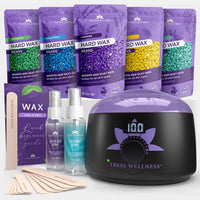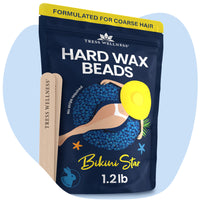If you’ve ever felt like you’re waging war against coarse hair, you’re not alone. It’s stubborn, it’s prickly, and shaving only makes it come back angrier—like that one friend who insists on showing up uninvited. So, is waxing better than shaving for coarse hair? Spoiler alert: it absolutely is. Waxing doesn’t just remove hair—it evicts it, root and all, leaving you with smoother, longer-lasting results.
Ready to break up with stubble and tame that wild hair? Let’s dive into why waxing is your new best friend for keeping coarse hair under control.
What’s the Difference Between Waxing and Shaving?

Before we jump into the specifics of coarse hair, let’s quickly break down the two methods:
-
Shaving cuts the hair at the skin’s surface using a razor. It’s quick, painless (mostly), but the results are short-lived. Coarse hair tends to grow back as sharp, stubbly strands within a day or two.
-
Waxing removes hair directly from the root. Hot or hard wax adheres to the hair and pulls it out completely, delaying regrowth for weeks. Over time, waxing can even reduce the thickness of coarse hair!
Why Coarse Hair is Tricky to Manage?

Coarse hair is typically thicker, darker, and has a more prominent root compared to fine hair. It’s commonly found in areas like the legs, underarms, bikini area, and face. Here’s why coarse hair can be a challenge:
-
Faster Regrowth: Coarse hair grows back quicker and feels more noticeable after shaving.
-
Stubborn Roots: The thicker hair shaft makes it harder to remove effectively with razors.
-
Stubble Woes: Shaving often leaves behind rough, sharp stubble because it cuts the hair bluntly.
-
Ingrown Hairs: Coarse hair is prone to curling back into the skin, increasing the chances of painful ingrown hairs.
Because of these factors, shaving can feel like a never-ending cycle. Waxing, on the other hand, tackles the problem at its root—literally!
Benefits of Waxing Over Shaving for Coarse Hair
So, why is waxing better than shaving for coarse hair? Let’s break down the key advantages:
-
Longer-Lasting Results
Waxing removes hair from the root, which means it takes longer for the hair to grow back. With shaving, regrowth happens within 1-3 days, while waxing can keep you smooth for 3-4 weeks. -
Softer Regrowth
When hair grows back after shaving, it feels stubbly because the blunt end of the hair shaft is exposed. Waxing, however, allows hair to grow back finer and softer over time. This makes regrowth less irritating and noticeable. -
Reduces Hair Thickness Over Time
Regular waxing weakens the hair follicle, leading to thinner, sparser regrowth. If you stick to a waxing routine, coarse hair will eventually become easier to manage. Shaving doesn’t offer this benefit because it only trims hair at the surface. -
Fewer Ingrown Hair
Waxing reduces the risk of ingrown hairs by removing the hair completely. When you shave, coarse hair can curl back under the skin, causing irritation. Proper waxing techniques—combined with exfoliation—can prevent these pesky ingrowns. -
Smooth, Stubble-Free Skin
Let’s face it: stubble is the bane of shaving. With waxing, you get smooth skin that feels soft to the touch, with no prickly texture. Perfect for areas like the bikini line or legs!
How to Wax Coarse Hair at Home?

If you’re ready to ditch the razor and embrace waxing, here’s how to get started:
Tools You’ll Need
-
Tress Wellness Waxing Kit: Includes a wax warmer, hard wax beads, and applicator sticks.
-
Pre-Wax Spray: Cleanses and preps your skin.
-
Hard Wax Beads: Best for coarse hair as they grip stubborn strands without irritation.
-
Post-Wax Spray: Soothes and hydrates the skin after waxing.
Step-by-Step Guide
-
Prep Your Skin: Clean the area using a pre-wax spray and gently exfoliate 24 hours before. Make sure the hair is at least ¼ inch long.
-
Warm the Wax: Heat the hard wax beads in the wax warmer until they have a thick, honey-like consistency.
-
Apply the Wax: Use an applicator stick to spread a thick layer of wax in the direction of hair growth.
-
Let It Set: Allow the wax to cool and harden slightly.
-
Pull It Off: Hold your skin taut and pull the wax off quickly in the opposite direction of hair growth.
-
Soothe the Skin: Apply a post-wax spray to calm the skin and reduce any redness.
Is Waxing Painful for Coarse Hair?

We won’t sugarcoat it—waxing coarse hair can sting a bit, especially the first time. However, the pain is short-lived, and regular waxing sessions make it more manageable as hair becomes thinner. To minimize discomfort:
-
Use a high-quality hard wax designed for coarse hair (like Tress Wellness Hard Wax Beads).
-
Hold your skin taut while removing the wax.
-
Take deep breaths and relax—tension can make the process feel painful!
FAQs
1. Does waxing hurt more if I have coarse hair?
Yes, coarse hair may cause more discomfort initially because of its thick roots. However, with regular waxing, the pain decreases as the hair becomes thinner.
2. How long does waxing last for coarse hair?
Waxing typically lasts 3-4 weeks, depending on your hair growth cycle.
3. Can I use hard wax for coarse hair?
Absolutely! Hard wax is perfect for coarse hair as it grips the hair without sticking to the skin, making removal more effective and less painful.
4. Can waxing reduce coarse hair over time?
Yes! Regular waxing weakens hair follicles, leading to finer and sparser regrowth.
5. Is shaving or waxing better for coarse facial hair?
Waxing is the better option because it removes hair from the root, providing longer-lasting results without the stubble caused by shaving.
Conclusion
So, is waxing better than shaving for coarse hair? Without a doubt, yes! Waxing offers longer-lasting, smoother results, reduces ingrown hairs, and weakens hair growth over time—making it a game-changer for those battling thick, stubborn hair. While shaving may be quick, the stubble, frequent upkeep, and coarse regrowth just don’t cut it.
If you’re ready to say goodbye to razors and hello to smooth, soft skin, try waxing with Tress Wellness’s easy-to-use hard wax kits. Trust us—your future self (and your skin) will thank you!




